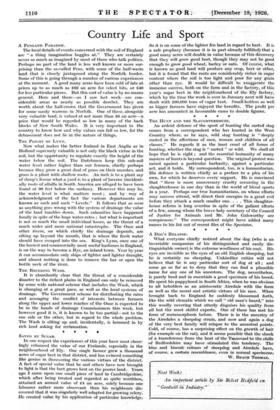Country Life and Sport
A PENLAND PARADOX.
The local details of events concerned with the soil of England are " a thing imagination boggles at." They are certainly never so much as imagined by most of those who talk politics. Perhaps no part of the land is less well known or more sur- prising than the so-called Fens, with some of the half-waste land that is closely juxtaposed along the Norfolk border. Some of this is going through a number of curious experiences at the moment. A good many acres have been sold of late at prices up to as much as £60 an acre for select bits, or 140 for less particular pieces. But this sort of value is by no means general. Here and there—as I saw last week—are con- siderable areas as nearly as possible derelict. They arc worth about the half-crown that the Government has given for some sandy warrens in Norfolk. One of these, alongside very valuable land, is valued at not more than £6 an acre—a price that would be regarded as low in many of the back blocks of New South Wales. It is very important to the country to know how and why values can fall so low, for the debasement does not lie in the nature of things.
THE PLIGHT OF LYNN".
Now what makes the better fenland in East Anglia as in Holland supremely valuable is not only the black virtue in the soil, but the opportunity to regulate exactly the height of the water below the soil. The Dutchmen keep this sub-soil water level rather higher than our fenmen, chiefly perhaps because they grow a great deal of grass on their marshes, and grass is a plant with shallow roots. An inch is to a plant say of sheep's fescue what a yard is to a plant of lucerne (incident- ally roots of alfalfa in South America are alleged to have been found at 90 feet below the surface). However this may be, the water .level is what matters most ; and by way of acknowledgment of the fact the various departments are known as such and such " Levels." It follows that as soon as anything goes wrong with the system of drainage the value of 'the land tumbles down. Such calamities have happened locally in spite of the huge water-rates ; but what is important is not so much the small individual losses, as the threat of a much wider and more national catastrophe. The Ouse and other rivers, on which chiefly the drainage depends, are silting up beyond the mouth, that is where the fresh water should have escaped into the sea. King's Lynn, once one of the busiest and commercially most useful harbours in England, is on the way to become a Rye, an inland town. Year by year it can accommodate only ships of lighter and lighter draught, and almost nothing is done to remove the bar or open the bottle neck of the river.
THE RECEDING WASH.
it is abundantly clear that the threat of a considerable disaster to the richest plains in England can only be removed by some wide national scheme that includes the Wash, which is changing at a great pace, as well as the local systems of drainage. The Government scheme for distributing the rates and assuaging the conflict of interests between farmers along the upper and lower reaches of the Ouse is expected to be in the hands of drainage Commissioners this week, but however good it is, it is known to be too partial—not to the one side or the other, but in regard to the whole problem. The Wash is silting up and, incidentally, is hemmed in by rich land asking for reclamation.










































 Previous page
Previous page